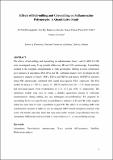| dc.contributor.author | MacFhionnghaile, Pól | |
| dc.contributor.author | Hu, Yun | |
| dc.contributor.author | Gniado, Katarzyna | |
| dc.contributor.author | Curran, Sinead | |
| dc.contributor.author | McArdle, Patrick | |
| dc.contributor.author | Erxleben, Andrea | |
| dc.date.accessioned | 2017-05-25T10:34:34Z | |
| dc.date.available | 2017-05-25T10:34:34Z | |
| dc.date.issued | 2014-04-11 | |
| dc.identifier.citation | MacFhionnghaile, Pól, Hu, Yun, Gniado, Katarzyna, Curran, Sinead, McArdle, Patrick, & Erxleben, Andrea. (2014). Effects of Ball-Milling and Cryomilling on Sulfamerazine Polymorphs: A Quantitative Study. Journal of Pharmaceutical Sciences, 103(6), 1766-1778. doi: https://doi.org/10.1002/jps.23978 | en_IE |
| dc.identifier.issn | 1520-6017 | |
| dc.identifier.uri | http://hdl.handle.net/10379/6545 | |
| dc.description.abstract | The effects of ball-milling and cryomilling on sulfamerazine forms I and II (SMZ FI, FII) were investigated using X-ray powder diffraction, infrared and near-infrared (NIR) spectroscopy. Cryomilling resulted in a complete amorphization of both polymorphs. Milling at room temperature gave mixtures of amorphous SMZ (FA) and FII. Calibration models were developed for the quantitative analysis of binary (FI/FII, FI/FA, and FII/FA) and ternary (FI/FII/FA) mixtures using NIR spectroscopy combined with partial least-squares (PLS) regression. The PLS models for binary (0%-100%), ternary (0%-100%), and low-level (0%-10%) binary mixtures had root-mean-square errors of prediction of 1.8%, 5.1%, and 0.80%, respectively. The calibration models were used to obtain a detailed quantitative picture of solid-state transformations during milling and any subsequent recrystallizations. FA prepared by cryomilling FI for less than 60 min recrystallized to mixtures of FI and FII, whereas samples milled for more than 60 min crystallized to pure FII. The effect of comilling SMZ with stoichiometric amounts of additives was investigated. SMZ formed amorphous materials with oxalic, dl-tartaric, and citric acids that were more stable toward recrystallization than FA. Amorphous SMZ/oxalic acid was found to recrystallize to a 2:1 cocrystal during storage. (c) 2014 Wiley Periodicals, Inc. and the American Pharmacists Association J Pharm Sci | en_IE |
| dc.description.sponsorship | This work was supported by Science Foundation Ireland under Grant No. [07/SRC/B1158] as part of the Solid State Pharmaceutical Cluster (SSPC). Mr. Dermot McGrath is thanked for DSC measurements. | en_IE |
| dc.format | application/pdf | en_IE |
| dc.language.iso | en | en_IE |
| dc.publisher | Elsevier | en_IE |
| dc.relation.ispartof | Journal Of Pharmaceutical Sciences | en |
| dc.rights | Attribution-NonCommercial-NoDerivs 3.0 Ireland | |
| dc.rights.uri | https://creativecommons.org/licenses/by-nc-nd/3.0/ie/ | |
| dc.subject | X-ray powder diffractometry | en_IE |
| dc.subject | Amorphous | en_IE |
| dc.subject | Near-infrared spectroscopy | en_IE |
| dc.subject | Stability | en_IE |
| dc.subject | Multivariate analysis | en_IE |
| dc.subject | Near infrared spectroscopy | en_IE |
| dc.subject | Solid state amorphization | en_IE |
| dc.subject | Process induced disorder | en_IE |
| dc.subject | Ray powder diffraction | en_IE |
| dc.subject | Physical stability | en_IE |
| dc.subject | Ranitidine hydrochloride | en_IE |
| dc.subject | Raman spectroscopy | en_IE |
| dc.subject | Crystal structure | en_IE |
| dc.subject | Molecular complexes | en_IE |
| dc.subject | Amorphous phase | en_IE |
| dc.title | Effects of ball-milling and cryomilling on sulfamerazine polymorphs: A quantitative study | en_IE |
| dc.type | Article | en_IE |
| dc.date.updated | 2017-05-19T07:28:54Z | |
| dc.identifier.doi | 10.1002/jps.23978 | |
| dc.local.publishedsource | https://doi.org/10.1002/jps.23978 | en_IE |
| dc.description.peer-reviewed | peer-reviewed | |
| dc.contributor.funder | |~| | |
| dc.internal.rssid | 6611277 | |
| dc.local.contact | Andrea Erxleben, School Of Chemistry, Room 150, Arts/Science Building, Nui Galway. 2483 Email: andrea.erxleben@nuigalway.ie | |
| dc.local.copyrightchecked | No | |
| dc.local.version | ACCEPTED | |
| nui.item.downloads | 909 | |


